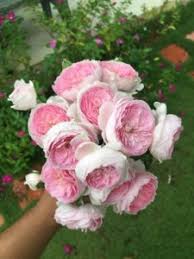
Rosa Gallica, commonly known as the Gallica rose, has embedded itself not only in gardens and landscapes but also in the rich tapestry of folk music and traditional melodies. Across cultures and centuries, the Gallica rose has inspired countless folk songs, ballads, and musical compositions, weaving its delicate beauty and symbolic significance into the fabric of traditional music and oral traditions. In this exploration, we delve into the enchanting world of folk songs featuring Rosa Gallica and the timeless melodies that celebrate its presence.
#### Symbolism and Inspiration:
1. **Floral Symbolism:** Rosa Gallica’s iconic blooms, with their velvety petals and captivating fragrance, have long served as symbols of love, beauty, and romantic longing in folk music. Its association with passion and affection often finds expression in tender ballads and love songs, where the Gallica rose becomes a poignant emblem of emotional expression and heartfelt sentiment.
2. **Cultural Significance:** Beyond its botanical beauty, the Gallica rose holds deep cultural and historical significance in many folk traditions. From ancient myths and legends to rural folklore and customs, Rosa Gallica embodies a rich tapestry of cultural meanings and symbolic associations, inspiring musicians and lyricists to weave its imagery into their songs and musical compositions.
#### Themes and Narratives:
1. **Love and Romance:** Folk songs featuring Rosa Gallica often center around themes of love, romance, and courtship, evoking the timeless allure of the rose as a symbol of affection and desire. These melodies express the tender emotions of lovers and admirers, celebrating the beauty and fragrance of Rosa Gallica as a metaphor for the sweetness of love and the joy of companionship.
2. **Nature and Landscape:** The Gallica rose’s connection to the natural world inspires songs that celebrate the beauty of the countryside, the changing seasons, and the rhythms of rural life. Whether in pastoral ballads or lyrical odes to nature, Rosa Gallica features prominently as a symbol of natural beauty and rural abundance, evoking images of lush meadows, blooming gardens, and idyllic landscapes.
#### Musical Styles and Instruments:
1. **Traditional Folk Music:** Folk songs featuring Rosa Gallica are often performed in traditional musical styles that reflect the cultural heritage and musical traditions of specific regions and communities. These songs may be accompanied by acoustic instruments such as guitars, fiddles, accordions, or traditional folk instruments, adding depth and authenticity to their melodic arrangements.
2. **Vocal Harmonies:** Vocal harmonies play a central role in many folk songs featuring Rosa Gallica, with singers weaving their voices together in rich, intricate melodies that evoke a sense of unity and shared experience. Whether sung in unison or in multipart harmony, these vocal arrangements lend a timeless quality to the music, inviting listeners to join in and experience the beauty of Rosa Gallica through song.
#### Cultural Heritage and Transmission:
1. **Oral Tradition:** Many folk songs featuring Rosa Gallica have been passed down through generations via oral tradition, preserved and transmitted by communities of singers, storytellers, and folk musicians. These songs serve as repositories of cultural heritage, embodying the collective memories, values, and experiences of past generations while continuing to resonate with contemporary audiences.
2. **Regional Variations:** Folk songs featuring Rosa Gallica exhibit a rich diversity of regional variations and stylistic interpretations, reflecting the unique cultural identities and musical traditions of different communities. Whether sung in rural villages, urban neighborhoods, or at festive gatherings, these songs reflect the vibrant tapestry of folk culture and musical expression across diverse landscapes and social contexts.
#### Conclusion:
Rosa Gallica’s presence in folk songs and traditional melodies underscores its enduring significance as a cultural symbol and botanical muse in the realm of music and oral traditions. Across cultures and generations, the Gallica rose continues to inspire musicians, lyricists, and folk artists to celebrate its beauty, symbolism, and cultural resonance through the timeless melodies of folk music. As these songs are passed down through the ages, Rosa Gallica’s legacy as a beloved muse in the world of folk music remains as vibrant and enduring as ever, ensuring its place in the hearts and imaginations of music lovers around the globe.
### Rosa Gallica in Folk Songs: Gallica Roses in Folk Music and Melodies
Rosa Gallica, known for its exquisite beauty and timeless charm, has found its way into the heart of folk music across diverse cultures and regions. In this exploration of Rosa Gallica’s presence in folk songs, we delve deeper into the enchanting melodies and lyrical narratives that celebrate the allure and symbolism of this iconic flower.
#### Cultural Reverence and Symbolism:
1. **Iconic Representation:** Rosa Gallica’s appearance in folk songs is a testament to its revered status in cultural symbolism. Often portrayed as a symbol of love, passion, and beauty, the Gallica rose embodies timeless themes that resonate deeply with audiences worldwide.
2. **Cultural Heritage:** Across centuries, Rosa Gallica has been a muse for countless folk musicians and lyricists, inspiring songs that reflect the cultural heritage and traditions of their respective communities. Whether in ballads, lullabies, or celebratory tunes, the Gallica rose serves as a poignant symbol of cultural identity and artistic expression.
#### Themes and Narratives:
1. **Romantic Allegory:** Folk songs featuring Rosa Gallica often explore themes of romance, longing, and unrequited love. Through evocative lyrics and melodious tunes, these songs capture the essence of human emotions, using the Gallica rose as a metaphor for the complexities of romantic relationships and the fleeting nature of love.
2. **Nature’s Bounty:** The Gallica rose’s association with nature’s beauty and abundance is a recurring motif in folk songs from around the world. Whether sung in pastoral settings or urban landscapes, these melodies celebrate Rosa Gallica’s role in the natural world, invoking images of blooming gardens, fragrant meadows, and verdant countryside.
#### Musical Styles and Instruments:
1. **Traditional Instruments:** Folk songs featuring Rosa Gallica are often accompanied by traditional instruments such as acoustic guitars, fiddles, flutes, and accordions. These instruments add depth and authenticity to the musical arrangements, enhancing the lyrical storytelling and emotional resonance of the songs.
2. **Regional Variations:** The musical styles and instrumentation of folk songs may vary depending on the cultural context and regional traditions. From Appalachian ballads to Celtic reels and Eastern European folk tunes, each region brings its unique musical flavor to songs that feature Rosa Gallica, enriching the tapestry of folk music with diverse sounds and rhythms.
#### Cultural Transmission and Heritage:
1. **Oral Tradition:** Many folk songs featuring Rosa Gallica have been passed down through generations via oral tradition, preserving the cultural heritage and storytelling traditions of communities around the world. Through sung narratives and communal gatherings, these songs continue to play a vital role in connecting people to their cultural roots and shared history.
2. **Contemporary Interpretations:** While rooted in tradition, folk songs featuring Rosa Gallica also evolve and adapt to contemporary musical sensibilities. Modern interpretations by folk artists and musicians breathe new life into these timeless melodies, ensuring that Rosa Gallica’s presence in folk music remains vibrant and relevant in today’s world.
#### Conclusion:
Rosa Gallica’s enchanting beauty and cultural significance have inspired countless folk songs and musical compositions, weaving its delicate petals and timeless symbolism into the fabric of folk music traditions worldwide. Whether as a symbol of love and romance or as an emblem of nature’s bounty and cultural heritage, the Gallica rose continues to captivate audiences with its enduring charm and lyrical allure. As these songs are sung and shared across generations, Rosa Gallica’s legacy in folk music endures, enriching the musical landscape with its timeless beauty and timeless themes.










